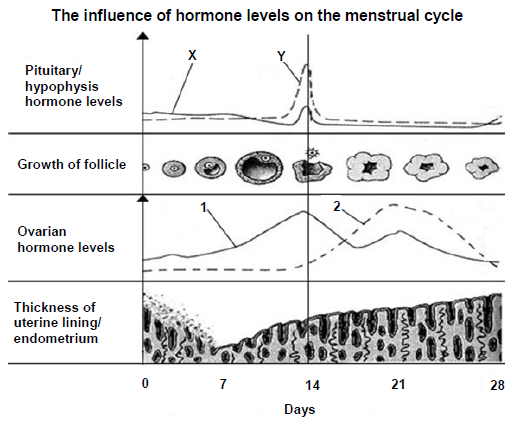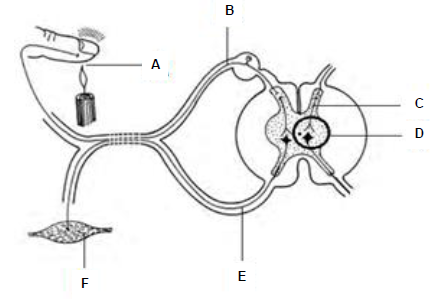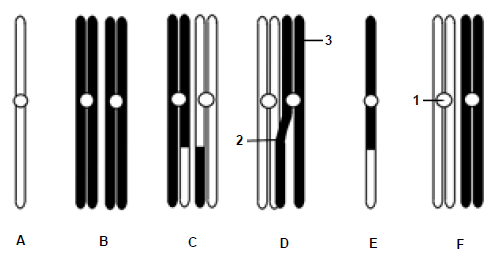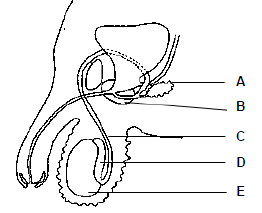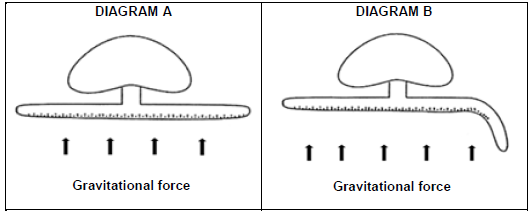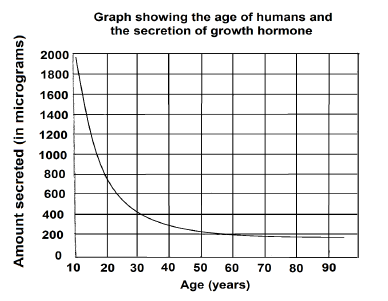LIFE SCIENCES PAPER 1 GRADE 12 QUESTIONS - NATIONAL SENIOR CERTIFICATE SEPTEMBER 2016
Share via Whatsapp Join our WhatsApp Group Join our Telegram GroupLIFE SCIENCES PAPER 1
GRADE 12
NATIONAL SENIOR CERTIFICATE
SEPTEMBER 2016
INSTRUCTIONS AND INFORMATION
Read the following instructions carefully before answering the questions.
- Answer ALL the questions.
- Write ALL the answers in your ANSWER BOOK.
- Start the answers to EACH question at the top of a NEW page.
- Number the answers correctly according to the numbering system used in this question paper.
- Present your answers according to the instructions of each question.
- ALL drawings must be done in pencil and labelled in blue or black ink.
- Draw diagrams, flow charts or tables ONLY when asked to do so.
- The diagrams in this question paper are NOT necessarily drawn to scale.
- Do NOT use graph paper.
- You must use a non-programmable calculator, protractor and a compass where necessary.
- Write neatly and legibly.
- Round off all calculations to two decimals after the comma.
SECTION A
QUESTION 1
1.1 Various options are provided as possible answers to the following questions. Choose the correct answer and write only the letter (A to D) next to the question numbers (1.1.1 to 1.1.10) in the ANSWER BOOK, for example 1.1.11 D.
1.1.1 The process in which male gametes are formed in humans is called …
- vasectomy.
- spermatogenesis.
- oogenesis.
- mitosis.
1.1.2 If the Eustachian tube is blocked, which of the following disabilities would be most likely to occur?
- Movement of food bolus to stomach would be prevented.
- Hearing would be impaired.
- Balance of the body would be upset.
- Elimination of urine would be impossible.
1.1.3 The phase in meiosis during which the chromatin network becomes visible as chromosomes:
- Prophase I
- Telophase II
- Anaphase
- Metaphase II
1.1.4 Internal fertilisation is the fusion of haploid nuclei of …
- male and female gametes in the female reproductive organ.
- male gamete and female gametes outside the female reproductive organ.
- a haploid male gamete with a diploid female gamete in the female reproductive organ.
- a haploid male gamete with a female somatic cell in the female reproductive organ.
QUESTION 1.1.5 AND QUESTION 1.1.6 REFER TO THE GRAPH BELOW WHICH SHOWS THE MENSTRUAL CYCLE AND THE INFLUENCE THAT DIFFERENT
HORMONES HAVE ON IT.
1.1.5 On which TWO days are the levels of hormones 1 and 2 the highest?
- 12 and 13
- 13 and 21
- 11 and 23
- 7 and 27
1.1.6 Which ONE of the following shows the trend of the level of hormones X and Y from days 13 to 14?
- X decreases and Y increases
- Both X and Y decrease
- X increases and Y decreases
- Both X and Y increase
1.1.7 The following functions are performed by the different parts of the brain:
- Being aware of what happens around you
- Controlling the breathing process
- Controlling voluntary movement
- Controlling muscle tone for effective posture
Which ONE of the following combinations represents the functions performed by the cerebrum?
- (i) and (iii)
- (i), (ii), (iii) and (iv)
- (i), (iii) and (iv)
- (ii), (iii) and (iv)
1.1.8 The part of the ear in which sound waves are converted into nerve impulses, is the …
- three ossicles.
- organ of Corti.
- three semi-circular canals.
- middle ear.
1.1.9 The following gases are found in the atmosphere:
- Carbon dioxide
- Methane
- Oxygen
- Ozone
Which ONE of the following combinations represent greenhouse gases?
- (i) and (iv) only
- (i), (iii) and (iv)
- (i), (ii) and (iv)
- (ii), (iii) and (iv)
1.1.10 Alien plants flourish in a new habitat because they …
- do not have natural enemies and therefore they are able to outcompete the indigenous species.
- are able to photosynthesise better than indigenous species.
- are able to defend themselves from diseases.
- are able to survive with limited resources.
(10 x 2) (20)
1.2 Give the correct biological term for each of the following descriptions. Write only the term next to the question number (1.2.1 to 1.2.10) in the ANSWER BOOK.
1.2.1 The extension of a cell body of a neuron which conducts impulses away from the cell body
1.2.2 Structures that sense changes in the environment and relay information to the central nervous system
1.2.3 A measurement of the total amount of greenhouse gases produced by an individual or company per period of time
1.2.4 The permanent destruction of forests
1.2.5 The variety of living species in the environment
1.2.6 A part of the nervous system that controls involuntary actions and has a homeostatic function
1.2.7 The hormone responsible for the conversion of glycogen to glucose
1.2.8 A hollow ball of cells into which the fertilised ovum develops
1.2.9 The membranes which enclose and protect the central nervous system
1.2.10 The part of the brain that maintains muscle tone, balance and equilibrium
(10 x 1) (10)
1.3 Indicate whether each of the description in COLUMN І applies to A ONLY, B ONLY, BOTH A and B or NONE of the items in COLUMN ІІ. Write A ONLY, B ONLY, BOTH A and B or NONE next to the question number (1.3.1 to 1.3.3) in the ANSWER BOOK, for example 1.3.4 B ONLY.
| COLUMN І | COLUMN ІІ | |
| 1.3.1 | Controls the metabolic rate in the body |
|
| 1.3.2 | The development in birds where the hatchlings can move soon after being born |
|
| 1.3.3 | Eggs incubated in nests |
|
(3 x 2) (6)
1.4 The diagram below represents a pathway making possible a process occurring in humans. Study the diagram and answer the questions:
1.4.1 Which process is made possible by the pathway shown in the diagram? (1)
1.4.2 Identify the LETTER that represents the …
- stimulus. (1)
- effector. (1)
1.4.3 Give the name of the microscopic gap represented by the part labelled D. (1)
1.4.4 Damage to which neuron (B, C or E) will cause the …
- inability to respond. (1)
- loss of sensation. (1)
- loss of both sensation and ability to respond. (1)
1.5 The diagram below represents the chromosomes at different stages of meiosis. (The shaded chromosomes are maternal in origin and the unshaded chromosomes are paternal in origin).
1.5.1 Write the LETTER that represents the following:
- The pairing of homologous chromosomes (1)
- Crossing over (1)
- Chromosome in anaphase 2 (1)
- Chromosomes in metaphase 1 (1)
1.5.2 Identify the parts labelled:
- 1 (1)
- 2 (1)
- 3 (1)
TOTAL SECTION A: 50
SECTION B
QUESTION 2
2.1 The diagram below shows the structure of a human male reproductive system.
2.1.1 Identify the structure and give ONE function for each of the following labels:
- A (2)
- C (2)
2.1.2 Identify the part B. (1)
2.1.3 Give the LETTER of the part that …
- produces the sperm cells. (1)
- serves as a temporary storage of sperms. (1)
2.1.4 Name the structure that is responsible for the transfer of sperm into the female reproductive tract. (1)
2.1.5 Explain what will happen to the ability to reproduce if the part labelled C is permanently blocked. (3)
2.2 Thando conducted an experiment to determine which gender has the faster reaction time amongst his classmates. Out of 15 learners in his class he randomly selected a sample of 5 girls and 5 boys. The following steps were followed for each member of the sample during the experiment:
- Thando held a meter ruler between his thumb and index finger just above the100 cm mark.
- The pupil placed the thumb and index finger on either side of the meter ruler at the 0 cm mark, with only the thumb touching it.
- As Thando dropped the meter ruler the pupil caught it by closing the thumb and forefinger.
- During each trial Thando recorded the distance at which the meter ruler was caught.
- The procedure was repeated five times for each pupil.
The table below shows the average distance at which the meter ruler was caught by 5 boys and 5 girls over five trials.
| Average distance at which the meter ruler was caught over 5 trials (cm) | |||
| Boys | Girls | ||
| Boy 1 | 5,8 | Girl 1 | 4,8 |
| Boy 2 | 5,0 | Girl 2 | 4,7 |
| Boy 3 | 4,9 | Girl 3 | 4,2 |
| Boy 4 | 4,8 | Girl 4 | 4,0 |
| Boy 5 | 4,6 | Girl 5 | 3,9 |
| Average (cm) | 5,02 | Average (cm) | 4,32 |
2.2.1 Thando’s initial hypothesis was rejected on the basis of the results obtained. Suggest what Thando’s initial hypothesis could have been. (2)
2.2.2 Identify the:
- dependent variable of the experiment, and (1)
- independent variable of the experiment. (1)
2.2.3 Give TWO reasons why the results of this experiment may be regarded as reliable. (2)
2.2.4 Mention TWO factors which should be kept constant during the experiment. (2)
2.2.5 State a reason why the reaction time of each individual probably improved as the trials progressed. (1)
2.3 Read the extract below and answer the following questions.
Recycling of waste materials Every ton (1 000 kg) of paper recycled saves 17 trees and uses 40 percent less |
2.3.1 What is meant by a landfill site? (1)
2.3.2 What is the possible amount of money that could be saved by South African Municipalities over two years if all household paper/cardboard were recycled? (1)
2.3.3 Suggest TWO reasons, other than the ones mentioned in the extract, for recycling household wastes. (2)
2.3.4 Apart from recycling, which TWO daily shopping habits could be adopted in order to reduce house hold waste? (2)
2.3.5 Explain how dumpsites and landfill sites contribute towards global warming. (2)
2.3.6 The recovery rates for various waste materials during the recycling process are given below:
| Waste material recovered | Percentage recovered |
| Cans | 69 |
| Paper | 59 |
| Glass | 25 |
| Plastic | 17 |
Use the above information to plot a bar graph to represent the data. (6)
2.3.7 Which ONE of the waste materials was …
- least recovered? (1)
- best recovered? (1)
2.4 Define the following terms:
2.4.1 Karyotype (2)
2.4.2 Eutrophication (2)
[40]
QUESTION 3
3.1 An experiment was conducted by a learner to investigate growth movements in plants. A seedling was placed horizontally in the dark as shown in diagram A.
Diagram B shows the results after 5 days.
3.1.1 Give the term for the movement of part of a plant in response to a stimulus. (1)
3.1.2 Which plant growth hormone stimulates the growth movement shown in Diagram B? (1)
3.1.3 Give any other TWO functions of the hormone mentioned in QUESTION 3.1.2. (2)
3.1.4 Does the accumulation of the hormone mentioned in QUESTION 3.1.2 inhibit or promote cell elongation in the growing tip of a stem? (1)
3.1.5 Explain why the part of the plant which showed a response as illustrated in the Diagram B, will react as shown. (6)
3.2 Describe the negative feedback mechanism between thyroxin and thyroid stimulating hormone (TSH). (6)
3.3 The graph below illustrates the secretion of growth hormone with age. Study the graph and answer the following questions:
3.3.1 Describe the trend observed in the graph. (2)
3.3.2 The highest growth rate is observed amongst teenagers. Give an observable reason from the graph to support this statement. (1)
3.3.3 Name the disorder resulting from …
- an over-secretion of hormone in the early days of one’s life. (1)
- an under-secretion of hormone in the early days of one’s life. (1)
3.3.4 State ONE function of the hormone in the physical development of a teenager. (1)
3.4 Read the following extract and answer the questions.
| Several recent studies have suggested a gradual decline in sperm production in men. Endocrine disrupters as well as life style have been suggested as risk factors. One life style factor that may affect human fertility is driving a vehicle for a prolonged period. It is suggested that the driving position may increase the scrotal temperature. |
3.4.1 State any ONE risk factor identified by the researchers. (1)
3.4.2 Explain why regular long distance driving with no breaks could possibly lower the sperm count in healthy males. (3)
3.4.3 Suggest a consequence of lower sperm count in males. (2)
3.4.4 State any ONE daily life style trend or routine (other than the one mentioned in the extract) that should be avoided to maintain the optimum scrotal temperature. (1)
3.5 Temperature regulation is an example of a homeostatic process.
3.5.1 What is meant by the biological term homeostasis? (2)
3.5.2 Which body organ is responsible for the maintenance of a constant body temperature? (1)
3.5.3 Explain why the body temperature must be kept constant? (2)
3.6 A learner consumed two packets of chips at break time.
3.6.1 Describe how the body controls salt concentration in the body fluids when the levels are high. (4)
3.6.2 Which other hormone works with the hormone mentioned in QUESTION 3.6.1 to effect homeostasis? (1)
[40]
TOTAL SECTION B: 80
SECTION C
QUESTION 4
A ball was hit 50 m high during a day-night cricket match. Amla ran very fast to position himself under the ball and caught it against the bright flood light.
Describe the changes that occurred in Amla’s eyes while he focused on the ball as it reached his hands and describe the changes that occurred when he looked at the bright light. Also explain the role of adrenalin in enabling him to run fast.
Content: (17)
Synthesis: (3)
NOTE: No marks will be awarded for answers in the form of a charts or diagrams.
TOTAL SECTION C: 20
GRAND TOTAL: 150
